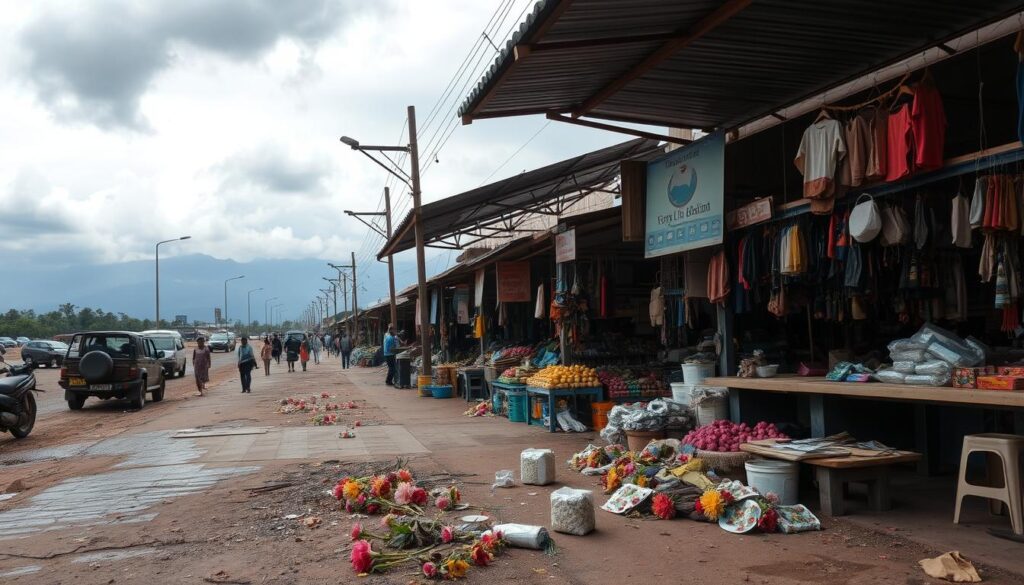Sri Lanka Declares Bankruptcy Amidst Economic Crisis 2022
The government of Sri Lanka recently declared bankruptcy, showing the depth of the Sri Lanka Economic Crisis Update. This event marks the worst financial crisis since the country gained independence. The economy’s downfall has led to widespread concern and uncertainty among officials and residents.

2022 has seen Sri Lanka’s financial struggles grow, facing debts of over US$6 billion. Its foreign reserves dropped to just US$1.9 billion. A part of the funds, US$1.5 billion, is locked in a deal with China. This situation has sparked urgent pleas for Sri Lanka Financial Emergency 2022 support.
The Sri Lankan Rupee fell by about 555% against the US Dollar, reaching a low of LKR 368.50. This drastic drop has led to increased food insecurity. Malnutrition rates are expected to jump from 13% to a dangerous 20%. Sadly, the number of very malnourished children might double.
The economic crisis has caused nationwide hardship. Items like food, medicine, fuel, and cooking gas are in short supply. This situation resulted in the resignation of former President Gotabaya Rajapaksa.
The Sri Lanka Economic Crisis Update suggests a challenging road ahead. Now, the current government and the possibility of a $3 billion IMF aid package are crucial. They must act wisely and negotiate effectively to overcome this financial challenge.
Unraveling the Roots of Sri Lanka’s Economic Despair
Sri Lanka’s economic stability has been worrisome for a while. It’s been hit by both inside and outside forces. This led to a severe money crisis. Understanding Sri Lanka’s Economic Despair Causes means looking at various factors. These include decisions on policy and global events.
The Impact of COVID-19 on Sri Lanka’s Economy
The global pandemic hit Sri Lanka hard. It made the already tough economic problems worse. This showed how weak the country’s financial system was. The Impact of COVID-19 in Sri Lanka was huge. It hurt the tourism industry a lot. This industry was key for foreign cash and jobs. When the virus spread, Sri Lanka’s economy went downhill. This stressed the country’s money stability a lot.
Contributing Factors: Tax Cuts and Money Creation Policies
Before COVID-19, certain decisions had already caused trouble. Huge tax cuts were meant to boost growth. But, they just reduced government money. This made the deficit bigger. At the same time, creating money to pay for this deficit led to inflation. This made the economic problems even harder to solve.
Foreign Exchange Crisis and the Refusal to Seek IMF Assistance
A key issue for Sri Lanka’s Economic Despair Causes was the money exchange crisis. This happened because the country spent too much on imports. Meanwhile, the money from exports and tourism went down. Not asking for help from the International Monetary Fund (IMF) meant losing out. Countries in crisis often get emergency funds and advice from the IMF. Sri Lanka’s decision likely sped up their economic downfall.

Looking at these issues, Sri Lanka’s economic trouble was bound to happen. This led to extreme steps and talks with other countries to try and fix the economy. More on the high inflation and how the government is dealing with it can be found here.
| Year | Foreign Debt ($) | Debt-to-GDP Ratio (%) |
|---|---|---|
| 2005 | 11.3 billion | N/A |
| 2010 | Increased | Gradual Increase |
| 2019 | 56.3 billion | 42 |
| 2021 | 56.3 billion | 119 |
The rise in foreign debt and Debt-to-GDP ratio shows growing financial stress. This data is key to understanding how bad money management led to current economic troubles.
Sri Lanka Declares Bankruptcy Amidst Severe Economic Crisis in 2022
In 2022, Sri Lanka saw a major economic downturn leading to bankruptcy. The country struggled with a lack of essential goods like food and medicine. This was due to a Sri Lanka Debt Default Situation. The crisis worsened as foreign exchange reserves fell sharply. They went from $7.6 billion in 2019 to just $50 million by May 2022.
The numbers show a grim economic picture. By July 2022, inflation had hit an all-time high of 54.6%. This was due to rising global food and fuel prices and failed economic strategies. Big tax cuts in 2019 cost the country over $1.4 billion in annual revenue. To counter the crisis, in early 2023, the government hiked income taxes for the wealthy, up to over 36%.
In response to the crisis, the IMF gave Sri Lanka a $3 billion loan. The World Bank also helped with a $600 million loan. This support is crucial for the country. To find out more, read the full story on the official Sri Lanka economic crisis page.
The government is working hard to fix the situation. They’re revamping state companies and selling the national airline to pay debts. In a first, Sri Lanka couldn’t pay an international debt in May 2022. This showed the severe financial problems they’re facing.
The plan going forward is to make deals with lenders for better repayment terms. This should help Sri Lanka recover over the long term. The goal is to cut debt payments to under 4.5% of GDP by 2027-2032. The aim is for Sri Lanka to become debt-free and more developed by 2048.
This situation in Sri Lanka can be a warning to other countries. It shows how crucial it is to have sound policies and international help during tough financial times.
A Closer Look at Sri Lanka’s Debt Dilemma
Sri Lanka is facing tough economic challenges due to its rising Sri Lanka Escalating Foreign Debt. This has made it hard for the country to handle its financial duties. These duties include paying back International Sovereign Bonds.
In the past, Sri Lanka started borrowing money through international sovereign bonds more. These bonds have higher interest rates than traditional loans. This change has caused Sri Lanka’s foreign debt to increase a lot. Now, the country might fail to pay its debts, which threatens its economy.
Escalating Foreign Debt: A Pathway to Default
Looking closely at financial changes over years, Sri Lanka’s leaning on foreign borrowing has grown. This increases the chance of not being able to pay back the debt. Amid these problems, the debt rose to $51 billion. This makes it harder to manage repayments.
The Domino Effect of Money Printing on Inflation
Since 2019, Sri Lanka’s Central Bank has been printing too much money to tackle budget deficits. This caused the national currency’s value to drop and inflation to rise. Initially, this was to manage short-term debt, but it ended up harming the economy more. Now, productivity is low, showing that the current economic plans are not working well.
International Sovereign Bond Repayment Debacle
This year, Sri Lanka is struggling with $4 billion in debt repayments. This includes a significant $1 billion international bond due in July. These repayment needs show how relying too much on unstable international debt markets can have bad effects.
| Year | Debt Repayment Obligations (USD) | Additional Financial Details |
|---|---|---|
| 2022 | $4 billion | $1 billion bond maturing in July; Coupled with a $78 million coupon payment |
| 2023 | Projection based on current restructuring | Focus on revenue enhancement and controlled spending |
| 2024-2026 | $29 billion (Cumulative) | Strategic debt restructuring and economic recovery plans underway |
The table above shows Sri Lanka’s tough road ahead in paying its debts while trying to stabilize and grow its economy. To get back on track, it needs a big change in how it earns money, governs more efficiently, and improves productivity.
The Dire Consequences and Societal Impact of Bankruptcy
In 2019, Sri Lanka began facing an economic crisis, which dramatically worsened by 2022, leading to a historic default on its foreign debt. This event affected various sectors, shown in detailed insights at Sri Lanka Economic Crisis Consequences. By the end of 2022, Sri Lanka had stopped paying its foreign debts. The country owed US$ 34.8 billion, while its foreign reserves dropped to about US$ 50 million.
Sri Lanka’s economic downfall is similar to the distress seen in Zambia and Ghana. These countries struggled with low reserves, high inflation, and a loss of investor confidence. Despite these countries’ challenges, Ghana received IMF support five months after defaulting. Zambia waited over two years. Their situations differ, but Sri Lanka’s issues are particularly grave. With increasing poverty, now at 25.9%, the nation faces severe food insecurity, malnutrition, and rising unemployment.
The banking sector in Sri Lanka is also suffering. By the end of 2022, the main banks saw a dip in their operations. From 2017 to 2019, the Return on Equity for these banks dropped significantly. Bad loans increased. These issues illustrate the tough situation as Sri Lanka fights to find balance. The economy shrank by 7.2% in 2022. Government debt reached nearly 126% of GDP. As a result, about 4 million people are living in poverty, with malnutrition becoming more common. This has prompted the government to look for ways to improve social systems and offer cash support to those in need.



